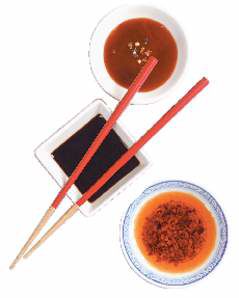Hot pot hits the spot
Published 5:00 am Tuesday, April 19, 2011

- Hot pot dipping sauces.
In Japan, it’s called shabu shabu. In Malaysia, it’s known as “steamboat” and in Switzerland, fondue chinoise. But to legions of Chinese and Chinese-Americans, it’s simply hot pot — and it’s the epitome of communal eating and window-steaming goodness.
A steaming pot of broth takes center stage at the family dinner table, surrounded by mounds of ready-to-cook raw vegetables, gleaming piles of fresh prawns and meat, and tangled heaps of noodles. As the dinner progresses, ingredients are added to the pot, where they merrily simmer away. Cooked tidbits are fished out with chopsticks and dipped in flavorful sauces, and at the end, noodles are added to turn the now-flavorful broth into a hearty soup.
Whether you opt for a lamb-centric Mongolian style, the bracingly spicy northern version or the mild southern style, there are endless provincial offshoots.
According to legend, it was Genghis Khan who invented the dish, when he was seized by a powerful hankering for mutton midway through a military campaign.
“It’s not easy to cook when traveling or fighting a war,” says Daniel Huang, manager of Union City’s Little Sheep Mongolian Hot Pot, relating the apocryphal tale. “So they made a nice broth, cooked (lamb) in the pot and made a good meal out of that.”
After eating 10 bowls of the stuff, the famous Mongolian leader handily won his next battle, ensuring the popularity of hot pot for centuries to come.
Today, China’s most famous hot-pot recipe hails from the city of Chongqing, near Sichuan, where the dish appears in restaurants, homes and at events such as a 2009 hot pot feast, which drew 200,000 diners. The Chong qing hot pot, which uses a traditional local soup known as ma la tang, has spawned numerous variations in cities to the north, including Beijing and Taiwan. The addictive ma la broth features a shockingly red slick of chili oil, which floats on top, chili pods and bits of burning Sichuan peppercorn, hence its name, which translates to “numbing and hot.”
While Mongolian and Northern hot pots tend to be oilier, spicier and more meat-focused, Southern-style hot pot is lighter fare, with an emphasis on seafood, including prawns and whole oysters. The Southern version features fresh vegetables, as well, including napa cabbage, mushrooms and bok choy. But with hot pot, the possibilities are limited only by one’s imagination, and aficionados regularly experiment with such ingredients as tofu, wontons, meatballs, fish cakes and even cubes of Spam. The diverse assortment of ingredients, combined with an infinite variety of dipping sauces, makes hot pot a completely individual experience.
Although Bay Area hot pot restaurants, such as San Jose’s Wuji Mala House and Richmond’s Coriya Hotpot City, abound, the dish is easy to make at home with a few specialized accouterments. The key is the pot itself, which comes in electric or open-flame versions. Electric hot pots, which run about $70, resemble slow cookers, and some offer dual containers to hold spicy and mild broths. Alternatively, diners can gather around a single-burner tabletop range (less than $20 at Asian supermarkets) that runs on inexpensive butane cartridges. Place a low-sided cooking vessel on top, fill it with boiling water or broth, and you’re ready to da been lo, as they say in Cantonese, or “to do next to the fire.”
And what a to-do it is. The wide array of fresh ingredients crowding the table provides a tableau of abundance, while the steaming pot exudes warmth and homeyness. The few-bites-at-a-time pace makes hot pot a leisurely and social affair, with plenty of time for conversation. And although everything is do-it-yourself, the experience is anything but individualistic. Like insistent Chinese aunties, experienced diners take turns fishing out ingredients, and plopping them in each others’ bowls.






